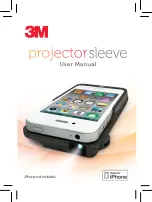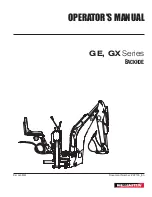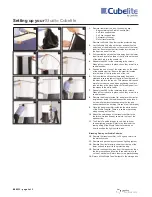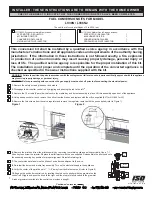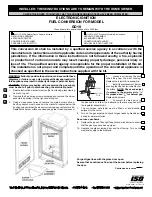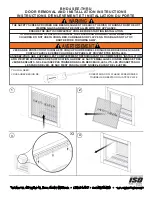
Rain Bird
Flow Sensors
Manual
9
Impeller Assembly and Shaft Replacement
If you are replacing an existing Rain Bird sensor and have already calibrated your flow transmitter, no
calibration changes are necessary. For installation of a new flow transmitter or for relocation of a sensor in a
new pipe size, please refer to the calibration instructions in flow transmitter manual.
1) Depressurize pipe from which sensor is to be removed.
2) For Insert Style Sensors: Remove the three (3) lock
nuts that secure the positioning collar to the threaded
rods of metal sensor. For Tee Type Sensors: Remove
clevis pin.
Figure 3
Impeller Assembly and Shaft Replacement
NOTE DIRECTION OF ARROW
NOTE:
Before removing lock nuts, record the dimension
from top of
2” NPT adapter to the bottom of the positioning
collar. This dimension will be required later to reinstall.
3) Remove the sensor from the hex adapter or the tee.
4) Note the impeller blade orientation relative to flow
arrows and the alignment hole in metal sensors beside
one of the sighting holes. In order to maintain proper
calibration, the impeller will have to be reinstalled in the
same manner with the impeller blades pointing toward
the small alignment hole, and into the flow direction as
indicated by the flow arrows.
USE PLIERS HERE
NOTE DIRECTION OF
IMPELLER
USE METAL PIN TO
REMOVE CERAMIC SHAFT
5) To remove the old impeller blade assembly, push the old shaft out of the sleeve with the new shaft (or small
diameter rod) just far enough to grab the end with a pair of pliers and pull the shaft completely out. The
impeller assembly will now be free, and will drop out.
6) Inspect the shaft and bearings for wear, and replace as necessary.
7) Refer to Figure 3. To reinstall, position the impeller in the cavity oriented as in Step 4 so that the impeller
blades point into the flow direction and toward the small alignment hole located beside one of the sighting
holes on metal sensors. For Brass Tee Type the flow direction arrow on the top of the sensor housing
should point downstream with the impeller blades pointing upstream.
8) Carefully push the shaft through the sleeve and impeller, taking care not to damage bearings. Make sure
that the shaft is inserted far enough so that it clears the sleeve on each side of the impeller housing.
NOTE:
If shaft is not carefully installed, the bearing can be deformed, preventing free rotation.
9) Inspect the O-rings for damage and replace as necessary. Clean the O-rings and the sleeve and lubricate
with silicone grease from the packet provided or some other acceptable lubricant.
10) Install the sensor into the
2” NPT adapter or tee so that alignment hole is facing upstream and flow arrows
point in the direction of the actual flow. Since the positioning collar was not loosened during this operation,
the studs should all line up perfectly when the sighting holes are parallel to pipe. If this has been
accidentally loosened, please refer to the installation instructions for the alignment of the flow sensor unit.
11) Install and tighten the nuts or replace the clevis pin.
12) For metal sensors, double check that the distance from the top of the
2” NPT adapter to the bottom of the
positioning collar equals the dimension as measured in Step 2, and holes in sleeve sight exactly down the
pipe, the arrows point in direction of flow and alignment holes located beside one sighting hole is pointing
towards the source. If not, refer to
Installation
section in this manual.
13) This completes the replacement procedure. The system may now be repressurized and tested.














